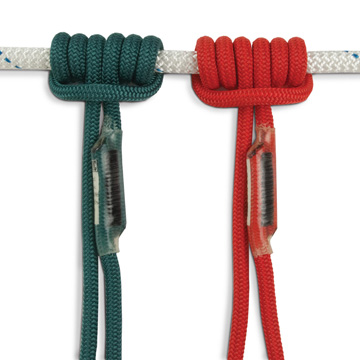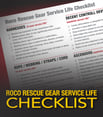Service Life Guidelines for Rescue Gear

I miss being a kid. No smart phones, no tablets, no TikTok. Twitter was what my stomach did if a cheerleader said hello in the hall. If you wanted to go run the streets with your friends until it got dark, you only had to do one thing. Get mom to tell you to get out of the house. It was a risky game. Act obnoxious enough and she told you to go play outside. Act too obnoxious and you risk getting sent to your room. The better way was to be the good kid. In my house, it sounded something like this.
Me: (yelling from my room) “MOM, CAN I GO OUTSIDE TO RIDE MY BIKE?”
Mom: “Did you finish your homework?”
Me: “Yes.”
Mom: “Is your room clean?”
Me: “Kind of.”
Mom: “Clean your room and you can go out.”
Me: “Why do I have to clean my room?”
Mom: “BECAUSE I SAID SO.”
And there it was, the true rallying cry of our childhood… BECAUSE I SAID SO.
Imagine if we applied that same conversation to Technical Rescue. Would it go something like this?
Rescuer: “Hey boss, can we rappel?”
Program Manager: “Have you inspected your gear?”
Rescuer: “We did that last year.”
Program Manager: “Inspect your gear and you can go rappel.”
Rescuer: “Why do we have to inspect our gear before we go rappel?”
Program Manager: “BECAUSE I SAID SO!!!!”
If only it were so easy. My mom should be the CEO of the World. Things would get done.
Today we have a multitude of resources for inspecting our equipment. These resources tell us when, who, how and how often. The myriad of guidance can sometimes make us wish mom would just send us to our room. Let’s take a look at those resources and decipher what truly needs done so we can just go rappel.
The first thing we need to know is this. Regardless of the stated service life, the condition of rescue equipment – as determined through inspection by a qualified person – is the primary factor in determining whether a piece of equipment is fit for service. Stated service life is the long game. Ongoing inspection programs are the short game that we rely on to keep our people safe.
Regardless of the stated service life, the condition of rescue equipment – as determined through inspection by a qualified person – is the primary factor in determining whether a piece of equipment is fit for service.
Manufacturers should always be the first resource. They built the equipment to required standards. They know best how to inspect the gear with their name on it. When you break out that new piece of kit and tear off that little attached book, turn that shiny piece of gear over and over in your hand. Admire the clean-cut router work and the gorgeous anodization. Then put it down and read the instructions. Every single time.
While the manufacturer’s booklets might look long, the user instructions are generally manageable and delivered in multiple languages. The few minutes reading the language section applicable to you will be invaluable. It will tell you what you can and can’t do, and it will tell you how to inspect it. How often do we get all of the information about something we buy in a small package that we can keep around? Take advantage.
Manufacturers vary in their specifications for service life of rescue equipment. Petzl specifically defines the “potential” service life of plastic or textile products to be no longer than 10 years. For metallic equipment, they state that service life is indefinite. CMC, on the other hand, does not give specified times for their hard equipment, stating “The service life of equipment used for rescue depends greatly on the type of use and the environment of use.” Because manufacturers use standards vary greatly, a definitive service life of the equipment cannot always be provided.
Although the definition of equipment lifespan is very broad depending on the manufacturer, each will provide specific instructions on proper inspection of equipment and detailed explanations on when to the retire service item.
Most manufacturers follow the same general guidelines for removing equipment from service. Several general identifiers that pertain to all equipment are shown below.
REASONS FOR EQUIPMENT RETIREMENT INCLUDE:
- Item fails to pass any pre/post use or competent person inspection.
- Item has been subjected to a major fall or load.
- Item is constructed of plastic or textile material and is older than 10 years.
- You cannot determine the complete full-use history of equipment.
- You have lost confidence in the equipment.
Most manufacturers will provide service for equipment items that are repairable. However, most caution against repair because the cost typically exceeds the cost of replacement. Any repairs attempted outside of the manufacturer’s guidance may void any warranty and will release the manufacturer from any liability or responsibility. All manufacturers recommend destroying equipment once it has been retired from service to prevent items from inadvertently being cycled back into active service.
Manufacturers also provide indicators for different types of equipment that require it to be retired from service. These not only capture the general conditions mentioned above, but also address conditions that are specific to each category of equipment. It is important to identify these specific conditions as they are vital to the dependability and functionality of each component. These are commonly categorized as harnesses, hardware and software.
Harnesses:
Harnesses are one of the most personal components of life safety equipment. Without a certified harness in serviceable condition, the best life safety rope and hardware will do little to protect the user. All individuals who are required to wear harnesses should be trained and authorized in the inspection process. Harnesses should be inspected before, during and after use as well as once annually by an individual deemed a competent person by the facility or department.
Harnesses should be inspected before, during and after use as well as once annually by an individual deemed a competent person by the facility or department.
Since harnesses are a nylon product, they fall under the guidelines set forth by ASTM International (formerly American Society for Testing and Materials) Consensus Standard F1740-96 and have a service life of 10 years. Manufacturers also state that hard or excessive use may significantly reduce service life. It is important to conduct routine inspections as well as keep records of harness use. This “usage” history could indicate signs that would require the equipment to be retired early.
Some conditions that may tell you it’s time to retire your harness:
- It has been more than 10 years since the manufacture date.
- Webbing shows signs of cuts, significantly worn or frayed areas, soft or hard spots.
- Webbing shows signs of discolored or melted fibers.
- Stitching shows signs of pulled threads, abrasion and/or breaks.
- Hardware shows signs of damage, sharp edges, excessive wear, or improper function.
- If the harness has been subjected to shock loads, fall loads, or abuse.
- If there is any doubt about the integrity of the harness.
If the harness demonstrates any of these conditions, it should be removed from service and destroyed.

Life Safety Rope, Webbing, Anchor Straps, Accessory Cord:
Software products are also nylon or textile based; and as such, they fall under the same inspection process as harnesses. A complete inspection of life safety rope and associated products includes not only a visual inspection but a tactile (or touch) inspection as well. The tactile inspection should be done with tension on the rope, webbing or strap.
The inspector is looking to identify any of the following conditions:
- Chafed, glazed or discolored surfaces (these areas should receive a more thorough inspection).
- Abrasions or cuts in the sheath where the core is exposed.
- Variation of diameter of the rope that could indicate potential damage to the core fibers.
- Soft or hard spots that could indicate core damage or that the fibers have been over stressed.
- If the rope has been subjected to shock loads, fall loads or abuse.
- It has been more than 10 years since the manufacture date.
A complete inspection of life safety rope and associated products includes not only a visual inspection but a tactile (or touch) inspection as well.
If any of these conditions are noted, then the item should be retired and destroyed immediately. It is important to remember that an accurate history should be maintained for all life safety rope products. The date of manufacture should be identified and recorded as products are being put into service. Equipment inspectors or users should ensure that these products do not exceed their service life. As with harnesses, the quantity, type and conditions of use can drastically reduce the service life of these products.

Carabiners:
Hardware such as carabiners, descent control devices, pulleys and cams are metallic and plastic. Because of these materials, they do not fall under the ASTM service life recommendation of 10 years. If these products are in serviceable condition and properly maintained, they have an infinite service life unless specifically noted by the manufacturer. Even though they do not have a dedicated service life term, it is still important to conduct the same pre/post use and annual inspections.
Some conditions that would require the equipment to be retired from service include:
- Gear has been dropped a significant distance.
- Exposed to heat sufficient enough to alter the surface appearance.
- Cracks, distortion or deep gouges.
- Corrosion or deep pitted rust. (Note: Surface rust may be removed with a fine abrasive cloth and coated with a preservative such as LPS #1 according the manufacturer’s recommendations.)
- Sharp edges that could cause damage to life safety rope (minor edges may be smoothed with the same process as rust removal).
- Gate does not line up when closed.
- Gate action does not return to closed position when opened and released.
- Locking mechanism does not fully engage.
- Complete history of use cannot be determined.
- Wear indicators are worn beyond manufacturer’s recommendation.
If any of these conditions exist, the equipment should be removed from service and destroyed. Records of use and inspection should be kept on these items even though the service life of the product is infinite.
Service History:
Service History is an extremely important part of ensuring life safety equipment is properly maintained and that service life is not exceeded. Not only does this help rescue teams control inventory and operational capability of equipment by documenting each use and inspection, it also assists the teams in forecasting budget costs for the replacement of items that are nearing the end of their service life.
Maintaining records of the manufacturer’s information received when purchasing new equipment is vital to identifying and keeping track of the manufacture date. It is also important to keep this information on file for the exact procedures for inspecting and removing equipment from service.
Service history is an extremely important part of ensuring life safety equipment is properly maintained and that service life is not exceeded.
If the manufacture date of equipment, such as life safety rope and harnesses, cannot be identified; it poses extreme liability for agencies or facilities whose teams may potentially be operating with equipment that has passed its service life. It could also create a compromise in the safe operation of the equipment.
If record-keeping of equipment inspection and use is not a primary focus of an organization, it could potentially expose team members to operating with unsafe equipment due to abuse or excessive/extreme conditions that go undetected.
Gear Inspection:
All team members should be qualified and knowledgeable enough to perform pre- and post-use inspections of equipment. It is crucial that all members document each use of equipment, denote any deficiencies, and report to the proper person. One person should be designated to perform the competent person annual inspection. This person should have complete knowledge of the equipment and inspection procedures as well as the authority to keep or remove equipment from service as they see fit. If team members are unable to fill this role, a qualified third party with applicable manufacturer certifications in competent person inspection should be brought in to assist in determining the condition and estimated service life of rescue equipment.
For assistance from our Roco Rescue equipment professionals, call us at 800-647-7626.
Brad Warr is a Senior Chief Instructor for Roco Rescue. He joined Roco Rescue in 2003 and currently teaches a wide variety of technical rescue classes including rope rescue, confined space rescue, trench rescue, and structural collapse. He is also a member of Roco’s Contracted Safety & Rescue Teams (CSRT), providing standby rescue services for plants, refineries and other industrial facilities. Brad became a firefighter for the Nampa (ID) Fire Department in 1998 and was promoted to Captain in 2006. He retired earlier this year. His responsibilities included training the department’s Heavy & Technical Rescue Team. Before joining the fire department, Brad worked as an Emergency Response Technician for a large manufacturer in Boise, where he was responsible for OSHA compliance, emergency medical response, confined space/rope rescue response and hazardous materials response.
Additional Resources

Gear Inspection Checklist (download)
Cleaning Your Rope…Here’s What the Experts Have to Say
Guidelines for Permanent Marking of Rescue Hardware




